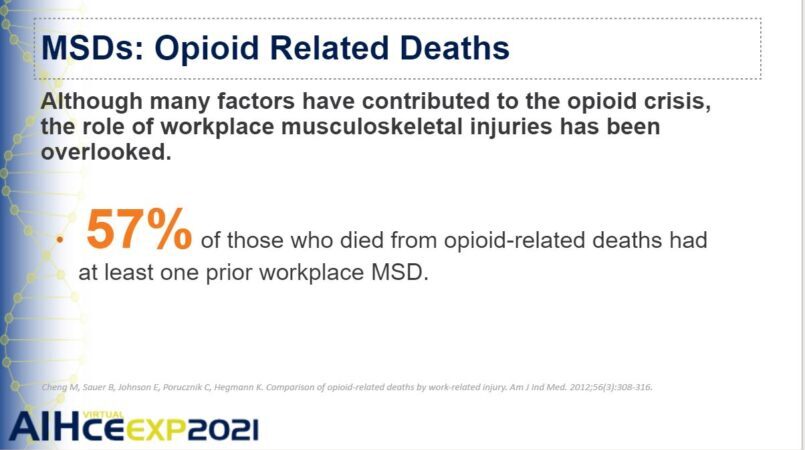Opioid misuse and addiction is an epidemic in the United States. But what does the opioid crisis have to do with ergonomics? National public health officials are responding to the opioid crisis by focusing on pain management and recovery services. But, VelocityEHS Director of Ergonomics Blake McGowan, CPE, said “There is a missing element to their approach” during the presentation “The Impact of Workplace MSDs on the Opioid Crisis” at the 2021 American Industrial Hygiene Conference. He also said, “It’s our duty, as EHS professionals, to identify and address the root causes of musculoskeletal disorders in the workplace. We can save lives by reducing the physical risk factors that lead to injuries in the workplace and the resulting prescription of opioid pain killers.” Here’s some facts you should know from his presentation.
- Approximately 130 Americans die every day from an opioid overdose.
- The rate of drug overdose involving opioids has been on the rise since 1999.
- Older Americans are overdosing on prescription painkillers, whereas younger Americans are increasingly during from heroin overdose.
The CDC is Combatting the Opioid Epidemic by
- supporting healthcare providers and health systems with data, tools, and guidance to improve opioid prescription writing.
- partnering with public safety officials and law enforcement to address the problem.
- encouraging consumers to make safe choices and raise awareness about opioid misuse and overdose.
The Missing Element of this Approach Is…
- workplace ergonomics
- 57% of those who died from an opioid-related death had at least one prior workplace MSD
- musculoskeletal disorders (MSDs) are painful disorders to the muscles, nerves, tendons, ligaments, joints, cartilage or spinal discs.
- primary biomechanical risk factors include forceful exertions, awkward postures, sustained exertions, high frequencies, and vibration.
EHS Professionals Need To…
- resource the problem to match the magnitude of the burden.
- follow the ergonomics methods to help you identify, quantify, and prioritize risk.
- implement solutions to reduce workers’ exposures to risk factors, such as frequency, forceful exertions, and awkward postures in the workplace.
For more on this topic, read this oldie but goodie article “Opioid-Related Overdose Deaths are Still Devastating Communities; Here’s How Ergonomics Can Help.”
